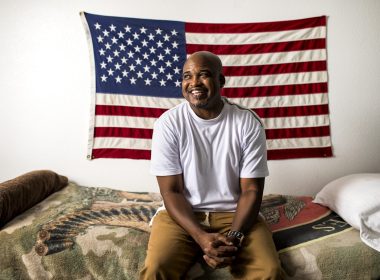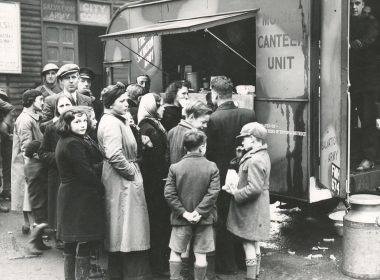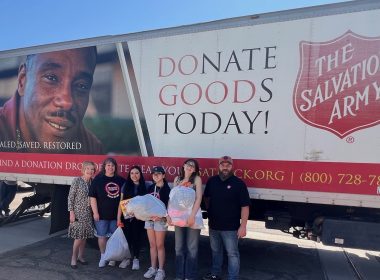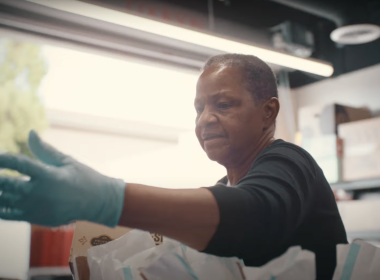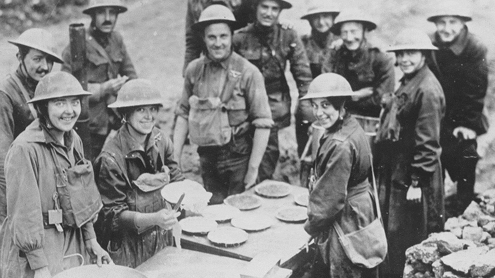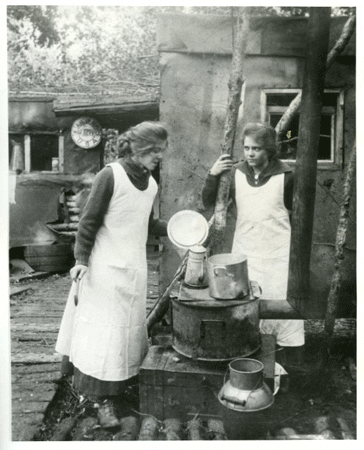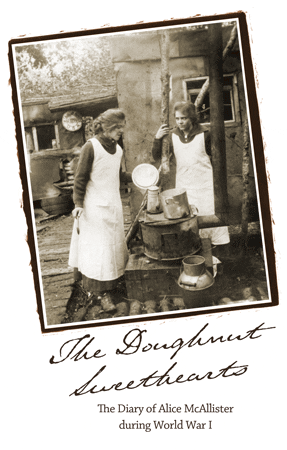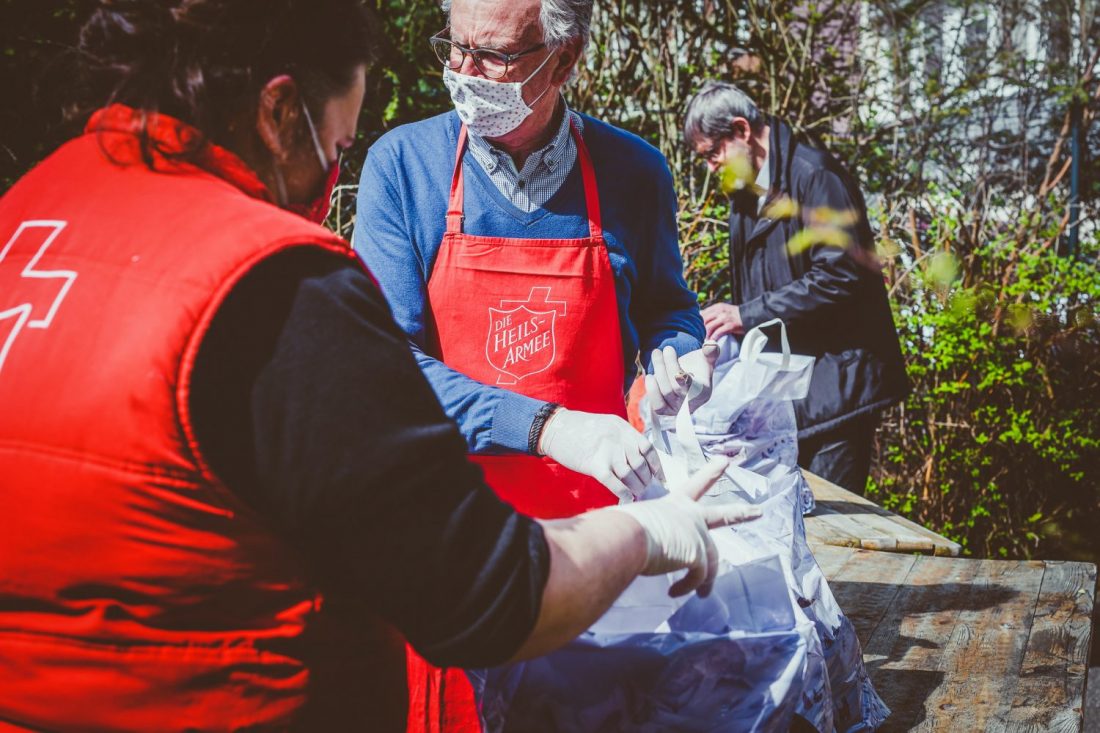Introduction and excerpt from The Doughnut Sweethearts: The Diary of Alice McAllister during World War I (Frontier Press, 2012)
Soon after President Woodrow Wilson declared war against Germany on April 7, 1917, Evangeline Booth, daughter of Salvation Army founder William Booth, created a National War Board to help meet the needs of American soldiers.
National, territorial and provincial war secretaries set up service centers and hostels adjacent to the U.S. military camps. Evangeline, however, wanted to do more than just serve the military in the U.S. She believed that if the American men were going to France, The Salvation Army must go with them.
Evangeline asked for a meeting with General John Pershing, who was already familiar with the Army. When his wife and children died in a fire, local pastors had largely ignored him as a transient in the community. Pershing never forgot a letter of sympathy he received from the local Salvation Army divisional commander.
Pershing first told Evangeline, “We already have an army over there,” but when reports came in that American soldiers were being demoralized by hardship and danger, a tentative go-ahead was all that Evangeline needed.
She sent Lt. Col. William S. Barker to France to find out how The Salvation Army could best serve American troops. Barker found that soldiers, who had expected to be participating in battles, found themselves drilling in mud from morning to night, causing an epidemic of homesickness to spread.
Barker cabled back to her: “Send over some lassies.” Evangeline was determined to send only the very best. She approached influential friends, who loaned the sum of $25,000 to begin operations, and later borrowed $100,000 from Salvation Army International Headquarters.
Evangeline handpicked the officers who were to go: No men were to go who were eligible to serve in the regular forces. Single women were selected for their devotion to duty, as well as their sterling character. All single women had to be at least 25 years old.
The first group she sent over consisted of 11 officers: a married couple, four single women and five single men. They were given regulation U.S. Army uniforms with skirts for the women, and red epaulets and the red Salvation Army shield on the hats. All were sworn in as U.S. Army privates, regardless of their Salvation Army rank.
Before they left Evangeline said, “You are going overseas to serve Christ. You must forget yourselves, be examples of his love, willing to endure hardship, to lay down your lives, if need be, for his sake. In your hands you hold the honor of The Salvation Army.”
By October 1917, ensigns Helen Purviance and Margaret Sheldon had been appointed to the 1st Division of the American Expeditionary Forces, at Montiers-sur-Saulx. After 36 days of steady rain, with a blanket of depression hanging over the whole area, the Salvationists agreed that the soldiers needed authentic home cooking. Supplies were low, however, and it was difficult to buy products locally. The only items they could purchase were flour, sugar, lard, baking powder, cinnamon and canned milk, so they decided to make doughnuts.
The first doughnuts were patted out by hand over small wood fire coaxed in a low, pot-bellied stove. Since it was difficult to lean over the low fire, Purviance spent most of the time kneeling in front of the stove.
“There was also a prayer in my heart that somehow this home touch would do more for those who ate the doughnuts than satisfy a physical hunger,” she said.
The tempting aroma of frying doughnuts drew a lengthy line of soldiers to the hut, waiting patiently in the mud and rain. Although the girls worked late into the night, they could serve only 150 doughnuts the first day. The next day, that number doubled. When they were fully equipped for the job, 9,000 doughnuts were made per day.
Soldiers asked if the doughnut could have a hole in it, so Purviance had an elderly French blacksmith improvise a doughnut cutter by fastening the top of a condensed milk can and camphor-ice tube to a wooden block.
The soldiers cheered the doughnuts and soon referred to Salvation Army lassies as “doughnut girls,” even when they baked apple pies or other treats.
The simple doughnut became a symbol of all that The Salvation Army was doing to ease the hardships of the frontline fighting soldier—the canteens in primitive dugouts and huts, with free refreshments, religious services, concerts and a clothes-mending service.
Doughnuts were so popular overseas that the war weary soldiers came back to America longing for the doughnuts they had been served during the war. One by one, bakeries responded and again, the doughnut was an instant success—only this time in America.
Today, Salvation Army Red Shields and USO units offer members of the armed forces a variety of services, ranging from attractive recreational facilities to family counseling, but the famous doughnut remains a perennial favorite. During every sort of emergency—fires, floods, earthquake, transit strikes or blackouts—The Salvation Army’s mobile canteens continually provide thousands of civilians with the doughnuts that stand for the Salvationist’s loving concern and readiness to help in times of need.
Violet Virginia McAllister (1890-1939) and Alice Annette McAllister (1892-1980) joined the 1st Division of the American Expeditionary Forces, sworn into the U.S. Army as privates—the only way for them to volunteer on the front lines of World War I.
They were given nursing training before boarding a steamship to cross the ocean in March 1918, going to war on behalf of the United States and The Salvation Army.
Within two weeks of arrival, Salvationists—132 men and 109 women—raised canteens and began serving American soldiers. They established a courier service, nursed the wounded, hauled water and wrote letters for the injured.
“They were charged by their commander in ‘that much greater art, the art of dealing ably with human life in all its varying conditions and phrases,” wrote Lettie Gavin in American Women in World War I: They Also Served.
With guitars in hand, the McAllister sisters performed for the troops, set broken bones and immunized for tetanus, but they became known for a simple luxury while at war—the doughnut.
“They made do with the simplest of supplies—a grape juice bottle for rolling pin, tin cans to cut the shape, a coffee percolator tube to make the hole. The day a line of 800 from the 26th Division lined up for the first 150 [doughnuts], they knew they had found their calling,” Judy Vaughn wrote in The Bells of San Francisco.
Alice McAllister kept a diary of her experience, presented in The Doughnut Sweethearts: The Diary of Alice McAllister during World War I (Frontier Press, 2012), with clarification from Mildred Mendell (the McAllister’s niece) after a first transcription by Captain Billy Francis. According to The Salvation Army’s officer records, Alice McAllister served on the front lines in France from March 31 to November 1, 1918, and again from February 8 to September 26, 1919.
Upon her return from the war, Alice McAllister served as a corps assistant in Philadelphia before her commissioning in May 1920 and appointment as the Philadelphia No. 11 corps officer. She was transferred to Trenton, N.J., in June 1921, and moved to the Western Territory in August 1923 where she worked in the women’s social office before being named corps officer of the San Francisco No. 1 Corps.
In March 1927, Alice resigned as a Salvation Army officer to marry Frank Baugh. They eventually moved to Placer County, Calif., where later Alice died on August 25, 1980.
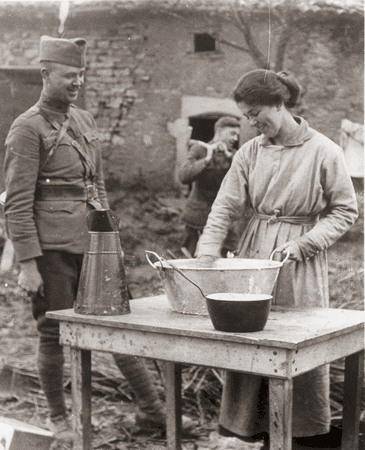 An excerpt from the diary of Alice McAllister
An excerpt from the diary of Alice McAllister
The hospital tents were already set up, the field kitchen force were in the act of cooking supper, and we were very hungry! The tent[s] were in a clearing in front of a high hill in which was a huge dugout that had been built by the Germans (the same as some we had been in before as we drove out the Germans and occupied their former quarters). The only unfortunate thing about them was that they had been built for shells coming from the opposite direction. The face of the hill, on our side of the hill, was cut away to make entrances to the tunnel leading back to the dugouts underneath the hill. On one side was a large room built of native stone, which our doctors had turned into a dressing room, and there was an entrance to the dugout from this room, too. The dugout ran the full length of the hill and was lined on each side with double-decker bunks. At the end there was a room with a door in it, and although I am sure it was intended for officers, it was given to us. We very gratefully set up our cots, spread our bedding rolls on them and made ourselves as comfortable as possible.
How can I ever describe the busy days at that field hospital! Our division was now hard at work driving the enemy back farther and farther toward their own country. It was that great drive in the Argonne Forest. The tents were filled with wounded [men] and ambulances were going and coming continually. In the dressing room, my sister was helping give tetanus shots and making a purple “T” on each forehead to signify that tetanus had been given. I was working in the tents at my usual job of washing mud and blood from faces and hands, administering drinks of water or moistening [the] lips of those too badly wounded to drink. Sometimes we worked far into the night, then snatched a few hours of sleep and were up and at it again.
One day, as I worked in a tent, a big shell suddenly landed in the open space in front of the tents. The colonel’s car was standing there and it was almost completely covered with mud and rocks. Immediately, we began carrying the wounded into the dugout. The shells were coming about every 20 minutes, but the tents were finally emptied and a sergeant said to me, “You had better get inside now.” I hastened across the intervening space to the door of the dressing room where my sister and the doctors were working. I had just closed the door when a shell landed right where I had been standing a moment before! Fortunately the ground was very soft from continuous rain and the shell had sunk deep into the earth before it exploded. However, the windows were shattered and rocks, some as big as a man’s hand, came hurdling into the room. Although the wounded were on litters all about the floor, no one was hurt.
Then began the work of getting these men back into the dugout. We all worked furiously, for we knew that another shell would come in at least 20 minutes. It did, and it tore off one comer of the building. Then another came, landing right on top of the entrance to the dugout just as the chaplain, taking my sister and I by the arms, said, “Ladies next.” Just as we were ready to step over the threshold, the shell exploded, bringing down heavy timbers, rocks and dirt. One step and we would have been underneath it all. The officers and hospital corps men stood there looking at us and realizing how near tragedy had been. Major Maynard looked around the room and said, “Men, you have just witnessed a miracle and I believe God has spared us because these two girls are with us.”
Get a copy of The Doughnut Sweethearts here!


